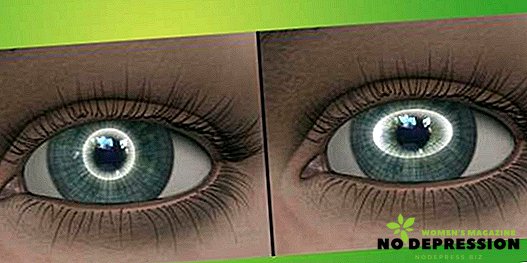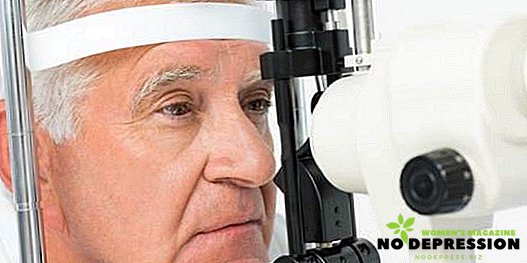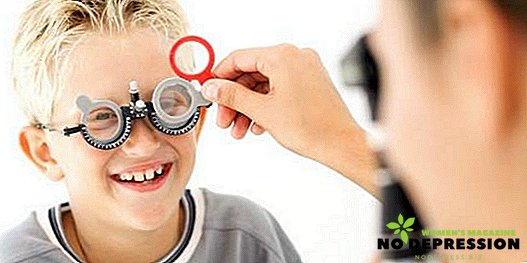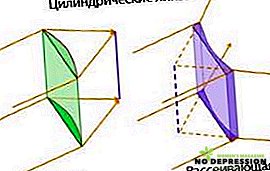Healthy eyes - a feeling of full life, when you can see loved ones, how children grow. Through our eyes we see the world around us in all its colors and splendor. Caring for them is right to help, to take care of overvoltage in time, to prevent our children from wearing glasses and losing their sight. It is quite real and depends only on us.
Astigmatism of the eyes: what is it, what is dangerous?
Astigmatism is a refractive distortion of the eye, that is, the refractive system fails. The inability to focus the light rays on the retina, which leads to the manifestation of the image in front of her or behind her. This defect is associated with a change in the shape of the lens, curvature of the cornea or damage to the eye, which leads to a loss of the possibility of clear vision.
Changes in the curvature of the cornea or lens lead to vision deformation. As a result, the retina shows the silhouette of a point as a blurred ellipse, segment or figure eight. Sometimes some objects fall out of the focus area.
Dangerous diagnosis of the development of amblyopia, strabismus and visual impairment.
Amblyopia (lazy eye) - decreases visual acuity with prolonged progressive astigmatism. There is a malfunction of the nervous structures of the retina, nerve fibers, and possibly neurons of the brain. In such cases, even after adjusting, visual acuity may not recover.
Because of the fuzzy and blurred outlines of objects, a person tries to focus his eyesight on the nearest object using all available methods: stretches the eyelid, squints, tilts his head to the side, such sophisticated methods for long-term use can lead to irreversible strabismus.
Types and degrees of astigmatism
Depending on changes in refraction:
- Corneal - due to defects of the cornea, more pronounced than the lens, because the cornea has the best ability to refract.
- Lens - caused by distortion of the shape of the lens.
When the shape of the cornea of the eye is distorted, the light beam moves along multiple meridians. The most important of them - vertical and horizontal, which are located to each other always at a right angle. If the visual defect is on the vertical meridian, it is called the direct, and on the horizontal - the reverse.
Types and subspecies:
| Types of astigmatism | From the location of the focus | ||
| plain | complicated | mixed | |
| farsighted (hypermetropic) | one of the main meridians has a refraction in the context of the norm, the other is far-sighted (focused behind the retina of the eye) | far-sighted refraction have both main meridians, are at different distances from the retina (focus behind it) | on one meridian is myopic astigmatism, and the other has a far-sighted |
| myopic (myopic) | one of the main meridians has a refraction in the norm and its focus is on the retina of the eye, and the other is focused in front of it (myopic refraction) | myopic refraction of two main meridians, the foci are at different distances in front of the retina | |
Astigmatism can affect one eye or both. Over the years, astigmatism decreases in 30% of patients, remains unchanged in 40%, and progresses in 25%.
From the nature of occurrence are divided into:
- Physiological. With this kind of disease, the difference in refraction between the main meridians is from 0.5 to 0.75 diopters. This slight difference does not impair vision, and there is no need for treatment. Experts associate this strain with the wrong growth of the eyeball.

- Pathological. Fluctuations that reach a dioptric unit in a fracture and cause a pathology of vision strongly affect the quality of vision and need adjustment.
- Congenital astigmatism. It is caused by genetic failure, requires constant monitoring by a doctor, detected by two years.
- Acquired astigmatism. May occur as a result of eye injuries or surgery. Possible after the transfer of viral diseases, maxillary pathologies.
Depending on the complexity:
- weak - up to 3 diopters;
- medium - from 3 to 6 diopters;
- strong - above 6 diopters.
Children's astigmatism
Often children appear already with a small astigmatism, which in the first year of life decreases and becomes less than one diopter. This is a physiological astigmatism that does not impair vision and is not treated.
 But if the child is anxious, complains of a headache or pain in the eyebrows, squinting, experiencing discomfort in the eyes, this is a reason to consult a doctor.
But if the child is anxious, complains of a headache or pain in the eyebrows, squinting, experiencing discomfort in the eyes, this is a reason to consult a doctor.
In identifying astigmatism, it is necessary to carry out a correction in a timely manner, to choose the right glasses, basically cylindrical lenses are prescribed for permanent use. Surgical intervention is not recommended until adulthood, as the visual system has not yet formed.
Often in children such a disease is congenital, transmitted with the wrong genes, so it is important to be examined by an ophthalmologist from 2 months.
The non-spherical shape of the cornea (defect in shape) is a congenital defect, which leads to the wrong light refraction and vision distortion.
Treatment of child astigmatism
The most common and inexpensive way is glasses. Points are selected depending on the individual tolerance and age of the child. It is necessary to constantly adjust the optics, selecting depending on the growth of the eyeball. The disease can be kept under control, if you follow all the recommendations of the ophthalmologist. Having diagnosed astigmatism in time, it is possible to prevent severe eye strain, the long process of which can cause complications.
 But there are negative aspects of wearing glasses. Often, the child feels a headache and severe fatigue, but these symptoms go away after a week. Otherwise, you need to replace the glasses. Limiting lateral vision, the inability to play sports also creates discomfort for children. There is a therapy that allows you to reduce the impact of glasses and eventually get away from such a correction.
But there are negative aspects of wearing glasses. Often, the child feels a headache and severe fatigue, but these symptoms go away after a week. Otherwise, you need to replace the glasses. Limiting lateral vision, the inability to play sports also creates discomfort for children. There is a therapy that allows you to reduce the impact of glasses and eventually get away from such a correction.
With a weak astigmatism of up to 1.5 diopters, hard lenses are prescribed, which are worn at night to correct the curvature of the cornea of the eye. Over time, this correction has a positive effect. This method is called Orthokeratology.
The modern technique using an excimer laser, safe, fast, takes only about 15 minutes. Does not require suturing and rehabilitation period. Improvement of vision occurs in a couple of hours, fully restored within a week.
The laser does not affect the deep layers of the eye, acting only purposefully on the cornea. Cutting off the surface tissue, it opens access to the flaws, evaporates part of the cornea and covers the wound with the cut layers. Restoration of the epithelium occurs due to collagen and independently without suturing. With this intervention, only local anesthesia is required.

Causes
A common cause is congenital abnormalities. All information from parents is transmitted to the fetus intrauterinely through 23 maternal and 23 paternal chromosomes. Each chromosome carries many genes that are responsible for the function and shape of the lens and cornea. And if at least one of the parents has a damaged gene, then the baby may show signs of astigmatism.
Bookmark violations of light refraction occurs already at the 6th week of pregnancy for the cornea and from 3 to 6 weeks for the lens.
Acquired reasons. Vision deteriorated in the process of influence of external factors.
It may be:
- eye injuries;
- postoperative complications;
- infectious diseases;
- dental pathology and diseases.
With penetrating injuries of the eye, the cornea and lens can be damaged. The subluxation of the lens and rupture of the ligamentous apparatus can also develop astigmatism. Inflammation of the cornea (keratitis), its thinning, lead to a distortion of the form (keratoconus).
Improper suturing or divergence after surgery. Stitching of the seams leads to deformation of the cornea and can cause high eye pressure.
They can also provoke diseases with teeth, jaws, deformation of the orbital walls (open bite, extension of the upper jaw forward, a large number of missing teeth).
Symptoms and diagnosis
Secondary symptoms of the disease are general malaise, fatigue, pressure and pain in the eyes, headache. All these factors cause stress, which a person experiences when trying to see a certain image, to focus on the object, since the primary causes elude his attention.
Primary symptoms:
- Loss of visual acuity. Compensated by increasing or decreasing the refraction of the lens.

- Distortion of visible images. Depending on which meridian has a large ability of refraction, such lines will be better seen by the patient (vertical or horizontal).
- Squinting. Reduces the curvature and refractive power of the vertical meridian, which can stabilize the vision in patients with direct astigmatism.
- Stretching the century. Improves eyesight in people with reverse astigmatism. Reduces the radius and the refractive ability of the horizontal meridian, at the same time increasing this ability in the vertical.
To clarify the diagnosis and determine the extent of the disease, the patient must undergo a series of examinations.
These include:
- Measurement of visual acuity. It is determined using special tables with letters of different sizes.
- Skiascopy (determination of the degree of change in the refractive ability of the optical system of the eye). In a room with darkened light, at a distance of one meter, the ophthalmologist directs the light from the lamp mounted on the side of the lamp to the patient’s pupil and studies the movement of the shadow on the retina, which directly depends on the state of the refractive ability of the eye. First, the type of astigmatism (myopic or hypermetropic) is determined, then with the help of lenses with different refractive power, the degree of refraction is determined.
- Refractometry. A special device with a refractometer with its measuring scale is used to diagnose astigmatism and its appearance. Directing the light of this device through its optical system, on which a certain sign is applied (three vertical lines and two horizontal lines), an image of this sign remains on the retina of the eye and, if they intersect, the refractive systems of the cornea and lens are not distorted. Otherwise, using the measuring scale to determine the degree of violation of the refraction of light.

- Ophthalmometry (determined by the curvature of the cornea). The refractive ability of the cornea and corneal astigmatism are revealed using an ophthalmometer apparatus. The method resembles refractometry. A specific image of the cornea is also projected and the result is determined by its location.
- Computer keratotopography. The modern method uses laser and computer development. The laser scans the cornea from different sides and with the help of a computer all information about the shape, refractive power, and distortion is processed.
- Biomicroscopy. Using a slit lamp for research, they study the cornea, lens, vitreous body in detail. Passing a thin strip through the diaphragm
- light, you can see the optical slice of the object, its front and rear walls. Examine the substance of the cornea itself, see the inflammatory processes and foreign bodies.
- Establishment of intraocular pressure. It is determined by placing a weight in the center of the cornea, and the degree of its deflection depends directly on the internal pressure.
- Determining the severity of the disease. Only suitable for determining direct astigmatism. Apply special glasses and lenses with varying degrees of refraction, so that the patient can see the letters of the tenth row of the table. Refraction of the lenses at which the result is achieved, and will determine the refraction of this meridian. The same procedure is carried out for another main meridian, and the difference in changes will correspond to the degree of astigmatism expressed in diopters.

Drug treatment
How to treat astigmatism? The main task of drug therapy to stop the deterioration of vision, improving microcirculation and metabolic processes in the tissues of the eye.
When prescribed by a physician, lens drops are used for lens astigmatism:
- udzhala;
- taufon;
- emoxipin;
- quinax.
Prescribed drops to relieve tension in the muscles of the eyes, use mezaton, atropine, mydriacil and tropicamide. Vasodilators are also prescribed, and for blood circulation to the brain of the medicine, piracetam and cinnarizine. And to strengthen the result of using vitamin therapy (myrtlene forte, okyuvayt, vitrum).
Lenses for astigmatism: types, advantages and disadvantages
The use of contact lenses is considered the most loyal method of vision correction, although it also has a number of advantages and disadvantages.
The advantages include:
- effective vision correction;
- does not distort the image (tight to the cornea);

- constant distance to the retina;
- imperceptible when wearing;
- preservation of lateral vision.
There are also disadvantages:
- there is the likelihood of inflammatory processes;
- myopia from oxygen starvation of the cornea may increase;
- inconvenience when replacing contact lenses;
- possibility of injury when using.
Any deficiencies can be minimized with proper use and implementation of all the recommendations of the doctor.
The most comfortable are toric lenses.
The special toric form is developed for the treatment of astigmatism and differs from the spherical form, which has two axes of different optical power.
The lens has a fixed position that corresponds to the strong and weak meridians.
Soft lenses (made of soft polymeric materials)
According to the degree of replacement, they are divided into:
- one-day;
- scheduled replacement (daily wear, with replacement after a maximum of a month, or once every three months, depending on the manufacturer);

- traditional (term of use up to 1 year).
Contact lenses made of hard materials, worn throughout the year:
- simple (have poor ability to pass oxygen);
- gas permeable (more than others gives access to oxygen, due to its rigid form it can correct astigmatism of moderate severity, even having a spherical shape).
Contact lenses are selected strictly by the doctor, individually for each patient.
Astigmatism treatment at home
The easiest way to alleviate the course of the disease is gymnastics for the eyes. This will help keep the muscles of the eyes in good shape and prevent diseases from developing. So, how to treat astigmatism with gymnastic exercises?
Here are the exercises:
- To focus on a close subject, then on the far, for 20-30 seconds each. Such alternation repeat up to 5 times.
- Slow rotation of the eyes clockwise, then against, for 20-30 seconds for each circle.
- Focus on the thumb of the outstretched hand. Perform hand motions up and down, right and left, following the eyes behind the thumb.

- Close your eyes for five seconds. Repeat several times.
- Draw the eyes of eight, five times.
- Massage the eyelids by circular motions.
This will help relax muscles, improve blood circulation and well-being.
Traditional medicine is also ready to help, most likely as preventive methods than curative ones.
Stress relief with cold water. Simple and effective. Dab in the eyes with cold water until relief. Relieves pain, cracks, redness.
The entrance is fruit and vegetable juices:
- carrots, beets and cucumbers (3: 1: 1);
- carrot fresh juice with aloe, add parsley and celery (7: 2: 2);
- infusion of blueberry leaves.
Not to mention the simple use of vegetables and fruits in raw form. Especially prized cherries, blueberries, spinach, dill, red beets, garlic, etc.
Prevention
Any prevention of astigmatism must begin with the right lighting, perhaps with point sources. Do not use fluorescent lamps, do not allow overloads, combining them with physical exertion. Perform gymnastics for the eyes, especially if the work is connected with the computer.
Properly selected vitamin complex will provide good support for eye health.
Conclusion
It is better to prevent the disease than to fight it heroically.
Simple rules for healthy eyes:
- planned passage of an ophthalmologist, especially in childhood;
- accurate implementation of all recommendations of experts, when any changes in vision occur;
- reduced eye strain;
- preventive measures.
Astigmatism is a disease that responds well to correction. The main thing - the right approach to this issue.
For more information on what astigmatism is, see the following video.



















